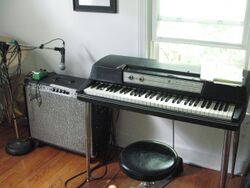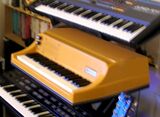Engineering:Wurlitzer electric piano
The Wurlitzer electronic piano, commonly called the Wurli, is an electric piano manufactured and marketed by Wurlitzer from the mid-1950s to the early 1980s. The sound is generated by striking a metal reed with a hammer, which induces an electric current in a pickup; although conceptually similar to the Rhodes piano, the sound is different.
Wurlitzer manufactured several different models of electric pianos, including console models with built-in frames, and standalone stage models with chrome legs. The latter became popular with several R&B and rock musicians in the 1960s and 70s, particularly Supertramp.
Sound
The official name of the instrument is the Wurlitzer Electronic Piano.[1] However, the sound is generated electromechanically by striking a metal reed with a felt hammer, using conventional piano action.[2] This induces an electrical current in an electrostatic pickup system using a DC voltage of 170v.[1][3]
Most Wurlitzer pianos are a 64-note instruments whose keyboard range is from A an octave above the lowest note of a standard 88-note piano to the C an octave below its top note.[4]The instrument is fitted with a mechanical sustain pedal.[1]
Compared with the equally-popular (Fender) Rhodes electric piano, the sound from a Wurlitzer is sharper and closer to a sawtooth wave, compared to the Rhodes which is closer to a sine wave. This gives the Wurlitzer a sharper and punchier tone.[5] When played gently the sound can be quite sweet and vibraphone-like, sounding very similar to the Rhodes; while becoming more aggressive with harder playing, producing a characteristic slightly overdriven tone usually described as a "bark".[3]
History
Inventor Benjamin Miessner had designed an amplified conventional upright piano in 1935, and Wurlitzer used his electrostatic pickup design, but replaced the strings with struck steel reeds. The improved model was co-invented by Paul Renard and Howard Holman for Wurlitzer in Chicago.[6][7] The instrument entered production in 1954[8] as the EP-110, followed by the 111 and 112 of 1955, and continued to be produced in various forms until about 1983-4 when production of the 200A ceased.[9][1]
Variations
Most Wurlitzer electric pianos are portable models with removable legs and the sustain pedal attached via a Bowden cable; console, "grand" and "spinet" models were also produced with a permanently attached pedal. The early models' sustain pedals actually attached through the right side of the instrument, with the pedal eventually being connected directly under the unit in later 1956, beginning with the model 112A.
Portable models
The earliest versions were the "100" series; these had a case made from painted fibreboard and were fitted with a single loudspeaker mounted in the rear of the case.[1] Apart from the 1950s models (110, 111, 112, 112A, 120), the portable Wurlitzer pianos featured a tremolo effect (officially "vibrato", although this was a misnomer) with fixed rate but adjustable depth.[10] Models produced until the early 1960s used vacuum tube circuitry exclusively; the 140 was the first solid-state model, introduced in 1962. The model 145 had a tube amp and came out around the same time as the 140 solid state pianos; the 145B, the final portable tube models, was finally phased out in late 1965, while the 140B continued. There was a solid state classroom variant called 146B, later renamed the 146. Ultimately, after the revisions designated with "A" and "B" suffixes, all of these portables were replaced in 1968 by the plastic-lidded 200, a much lighter instrument (56 pounds (25 kg) without the legs or pedal) with two loudspeakers facing the player. This model was updated as the 200A in 1974 and continued in production into 1983. The 200 was available in black, dark "Forest Green", red or beige. The 200A was only available in black and avocado green. The white Wurlitzer sometimes seen being used by bands such as the Beach Boys, the Carpenters and Supertramp was a custom painted finish not made by the manufacturer. The last version to be introduced was the 200B in 1978; this was visually identical to the 200A but was designed to be powered by a pair of medium-tension (85v) rechargeable batteries; it had no internal speakers or amplifier.
Console models
One important role for the Wurlitzer piano was as a student instrument in school and college music labs, and non-portable console versions were made for this purpose. The teacher had a headphone and microphone to be able to listen into each student individually and talk to them without others hearing them. All students listened to each of their instruments through headphones. Up to 48 individual student instruments could be connected together. According to former Wurlitzer employee Bill Fuller, 75% of all universities used Wurlitzer piano labs in the late 1960s or early 1970s, and some facilities were still in operation as late as 2000.[9] Those usually seen resemble a beige or light green Model 200 mounted on a matching pedestal containing a loudspeaker, headphone niche and sustain pedal. On these models there is no tremolo (although earlier models simply have the facility disabled). Some of these models were given the designation 206/206A. Many console models have recently[when?] been modified to 200/200A specification for use on stage. Rarer than the student models are the teacher consoles (207/207VA/205V, etc.), featuring multiple monitor/mute switches and, in some cases the facility to add a large illuminated display panel ("Key Note Visualizer") operated via the keyboard.[11] Standalone classroom consoles were the 214/215 series, and home/stage consoles were the 203, 203W and 210. An unusual, angular version was the 300, only available in the UK and EU around early 1973.[12]
106P
A rare version, and the only known model not to have 64 keys is the 106P (P for "Pupil"), a 44-note classroom model with a plastic case, no controls, one loudspeaker and no sustain pedal. The 106P was available as a set of eight on a folding frame, forming a portable keyboard lab. They were attached by an umbilical to a full size teacher piano with controls to feature each pupil piano. This model appears to date from the early 1970s and was available in orange or beige. Page McConnell, of the rock band Phish, is a prominent user of this model. Due to its small stature and color it was nicknamed “lil punkin,” and the size allows him to fit more gear in his designated stage area.
Other models
Spinet versions
Since production began, small numbers of wood-cased spinet-style instruments were made for domestic use. These usually had an upright-piano style soft pedal (actually an electronic attenuator) as well as the sustain pedal. The mechanism of these pianos is identical to that of the contemporary portable version. The model 700 was the same amplifier and action as the portable model 120. The model 700 was produced circa 1958–1962. The longer-keyed model 720 was the spinet version of the 145 tube model; the model 720A, in two consecutive design variations, was a spinet variation of the 145A and 145B, respectively; and the 1966-7 720B was a version of the solid state 140B. A classroom console called the 726B (later renamed the 726) was a console variant of the 146(B) solid state classroom portable. The model 720 and its variants were produced circa 1962–1967.
An especially rare Wurlitzer was the Europe-only model 300 (circa early 1973), which was an angular console-type piano based on the model 200. The model 300 looked similar to a modern home-use digital piano.
Butterfly Baby Grand
The 200A uniquely had a domestic sister model 270 called the "Butterfly Baby Grand", a semicircular, walnut finish wooden-cased piano with twin quadrant-shaped lids angled above horizontally mounted 8" loudspeakers. This was among the last Wurlitzers designed (released 1976), and is difficult to find. It is also the heaviest Wurlitzer ever produced.
Clones
The Wurlitzer is emulated in several modern digital keyboards, though its electromechanical sound production is difficult to emulate in a synthesized instrument. The Korg SV1 has been critically praised for its accurate emulation of a Wurlitzer.[14] The Nord Stage includes several different Wurlitzer patches.[15]
Notable users
Though jazz pianist Sun Ra used the instrument for his 1960 album Angels and Demons at Play, the first documented commercial recording using the Wurlitzer was two years earlier, Steve Allen's "Electrified Favorites" of 1958, prominently featuring the new keyboard (Coral 57185).[16] It was later used by Ray Charles and Joe Zawinul.[17] The instrument was used extensively by Supertramp in the 1970s, in songs such as "Goodbye Stranger" and "Dreamer".[17][18]. Neil Young also used it in songs like See the Sky About to Rain.
Examples
"Money (Pink Floyd song)"
"Waterloo Lily"
"Do It Again (Steely Dan song)"
"How Do You Sleep? (John Lennon song)"
"What'd I Say"
"You're My Best Friend (Queen song)"
"The Logical Song"
"Top of the World (The Carpenters song)"
"I Heard It Through the Grapevine"
"Eye in the Sky (song)"
"Miss You (Rolling Stones song)"
References
Citations
- ↑ 1.0 1.1 1.2 1.3 1.4 Palkovic 2015, p. 156.
- ↑ Shepherd 2003, p. 32.
- ↑ 3.0 3.1 Collins 2014, p. 308.
- ↑ Sussman 2012, pp. 27–28.
- ↑ "Rhodes vs Wurlitzer : Comparing classic electric pianos". reverb.com. March 6, 2015. https://reverb.com/uk/news/rhodes-vs-wurlitzer-comparing-classic-electric-pianos. Retrieved December 1, 2017.
- ↑ Chronicle, Augusta (September 2010). "Paul Renard Obituary". http://www.legacy.com/obituaries/augustachronicle/obituary.aspx?n=paul-s-renard&pid=145604377. Retrieved 18 March 2018.
- ↑ Grant, US (April 1959). "Electric Piano Amplifier". https://patents.google.com/patent/US2881650. Retrieved 18 March 2018.
- ↑ "Rudolph Wurlitzer to Produce Electronic Practice Piano in Fall" Music Trade Review, August 1954, 31.
- ↑ 9.0 9.1 Vail 2000, pp. 276–277.
- ↑ Vail 2000, p. 276.
- ↑ "A Rare Breed Indeed: The Wurlitzer Student Model Classroom". The Workshop Blog. The Chicago Electric Piano Co.. June 26, 2012. http://chicagoelectricpiano.com/a-rare-breed-indeed/wulitzer-student-model-classroom/. Retrieved May 22, 2014.
- ↑ "Wurlitzer Electric Piano models: a list.". docwurly.com. November 16, 2018. https://docwurly.com/wurlitzer-ep-history/wurlitzer-electric-piano-models-a-list/. Retrieved November 16, 2018.
- ↑ Electronic Piano Series 200 and 200A Service Manual, DeKalb, Illinois: The Wurlitzer Company, http://manuals.fdiskc.com/flat/Wurlitzer%20Series%20200%20Service%20Manual.pdf
- ↑ "Korg SV1". Sound on Sound. October 2009. https://www.soundonsound.com/reviews/korg-sv1. Retrieved December 1, 2017.
- ↑ "Wurlitzer". Nord Keyboards. http://www.nordkeyboards.com/sound-libraries/nord-piano-library/electric-piano/wurlitzer. Retrieved December 1, 2017.
- ↑ "Sheridan, Phil. "Record Review." Philadelphia Inquirer, 17 February 1958.
- ↑ 17.0 17.1 Burgess 2014, p. 76.
- ↑ Shepherd 2003, p. 302.
Sources
- Burgess, Richard James (2014). The History of Music Production. Oxford University Press. ISBN 978-0-19-938501-0.
- Collins, Mike (2014). In the Box Music Production. CRC Press. ISBN 978-1-135-07433-3.
- Palkovic, Mark (2015). Wurlitzer of Cincinnati: The Name That Means Music To Millions. Arcadia Publishing. ISBN 978-1-626-19446-5.
- Sussman, Richard (2012). Jazz Composition and Arranging in the Digital Age. Oxford University Press. ISBN 978-0-195-38099-6.
- Shepherd, John (2003). Continuum Encyclopedia of Popular Music of the World: VolumeII: Performance and Production. A&C Black. ISBN 978-0-826-46322-7.
- Vail, Mark (2000). Vintage Synthesizers. Backbeat Books. ISBN 978-0-879-30603-8.










